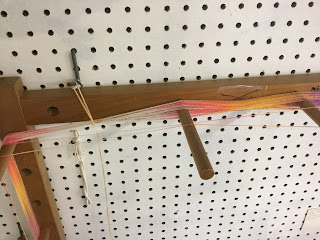I posted back in July about my latest loom restoration, and have been weaving on this old Swedish 10-shaft counterbalance loom.
Since I didn't know anything about a counterbalance loom with more than four shafts, I decided that was where I would start.
The only tie-up cords on the loom were the ropes on the front and back beams. I had to make and figures out the rest.
I didn't have many spare string heddles, but found enough to make a test warp with about 170 ends.
Laila Lundell's book, The Big Book of Weaving, was very helpful with all the set-up. I didn't have any Texsolv for the tie-ups, so I just used cording I purchased from the hardware store. I figured it was cheaper if I made a mistake cutting lengths and could always be replaced once I had the loom working properly.
This shows the stage of leveling the shafts before tying up the lamms and treadles.
My first few inches of a four-shaft goose-eye pattern. Everything seemed to be working properly.
This was my first experience using shaft levelers, the two notched bars hanging from one of the cross pieces. I didn't have any, so Bob made me a couple sets, one for six shafts and one for ten. The upper shafts fit into the notches and the whole set-up starts with them being hung from the beam above and leveled.
Notice the loom is still set-up in the garage. I decided to wait to put Julie (named after her previous owner) in the studio until I finished the first warp, since there was more room to move around the loom. It is hard enough at my age to crawl around under a loom, but even worse if it is in cramped quarters.
Success with four shafts!
I was able to get a long and a short table runner out of the sample warp.











